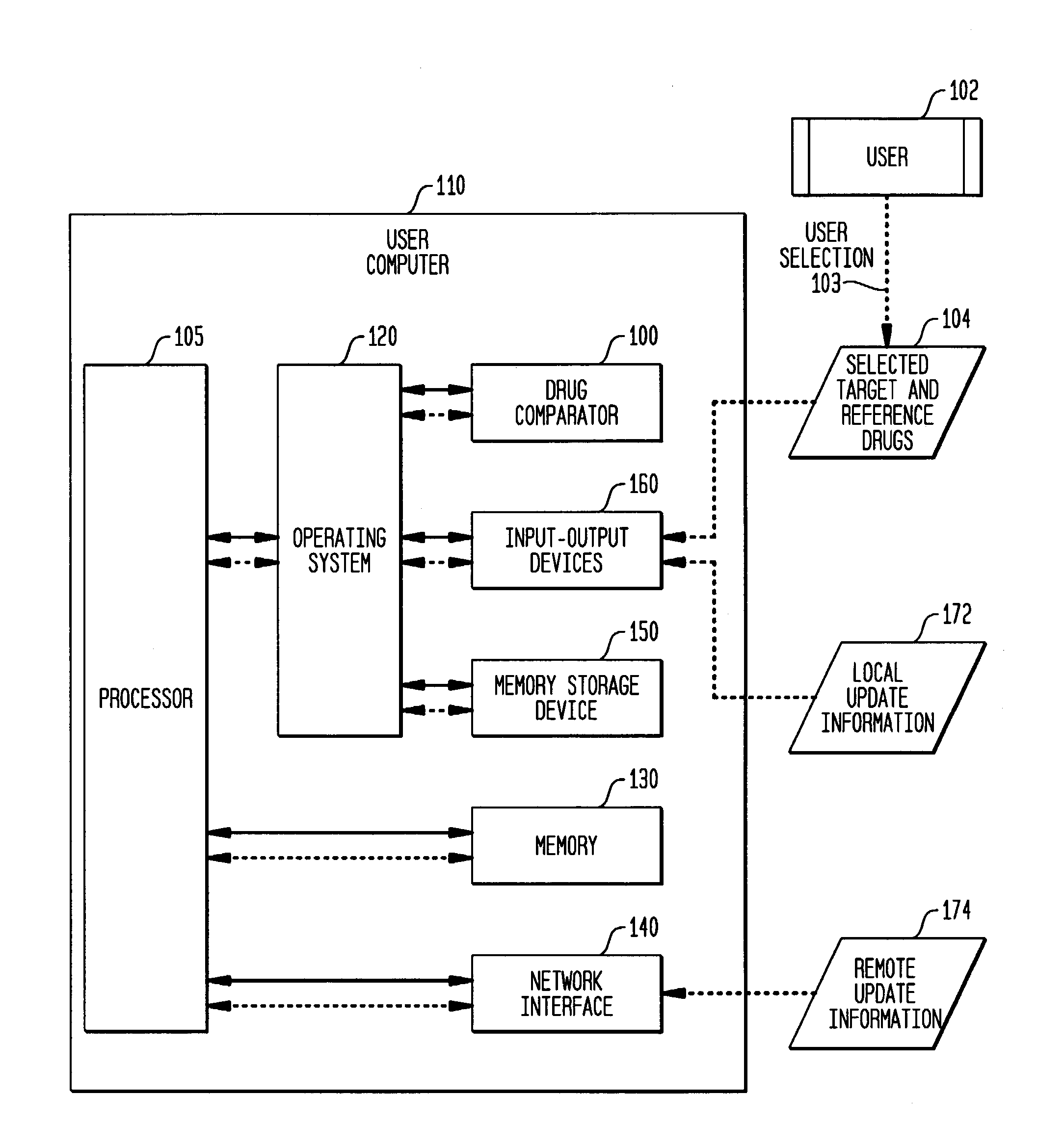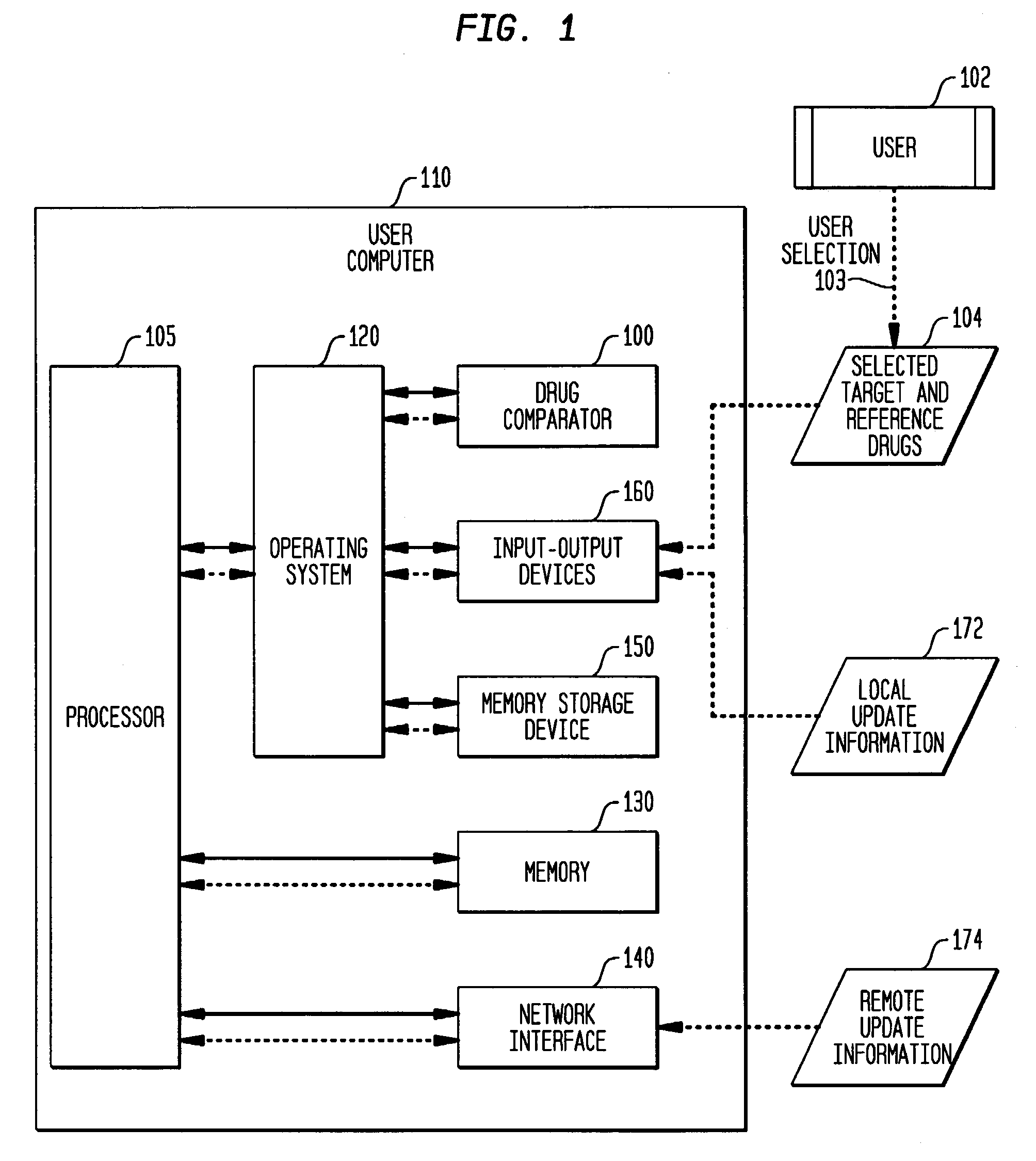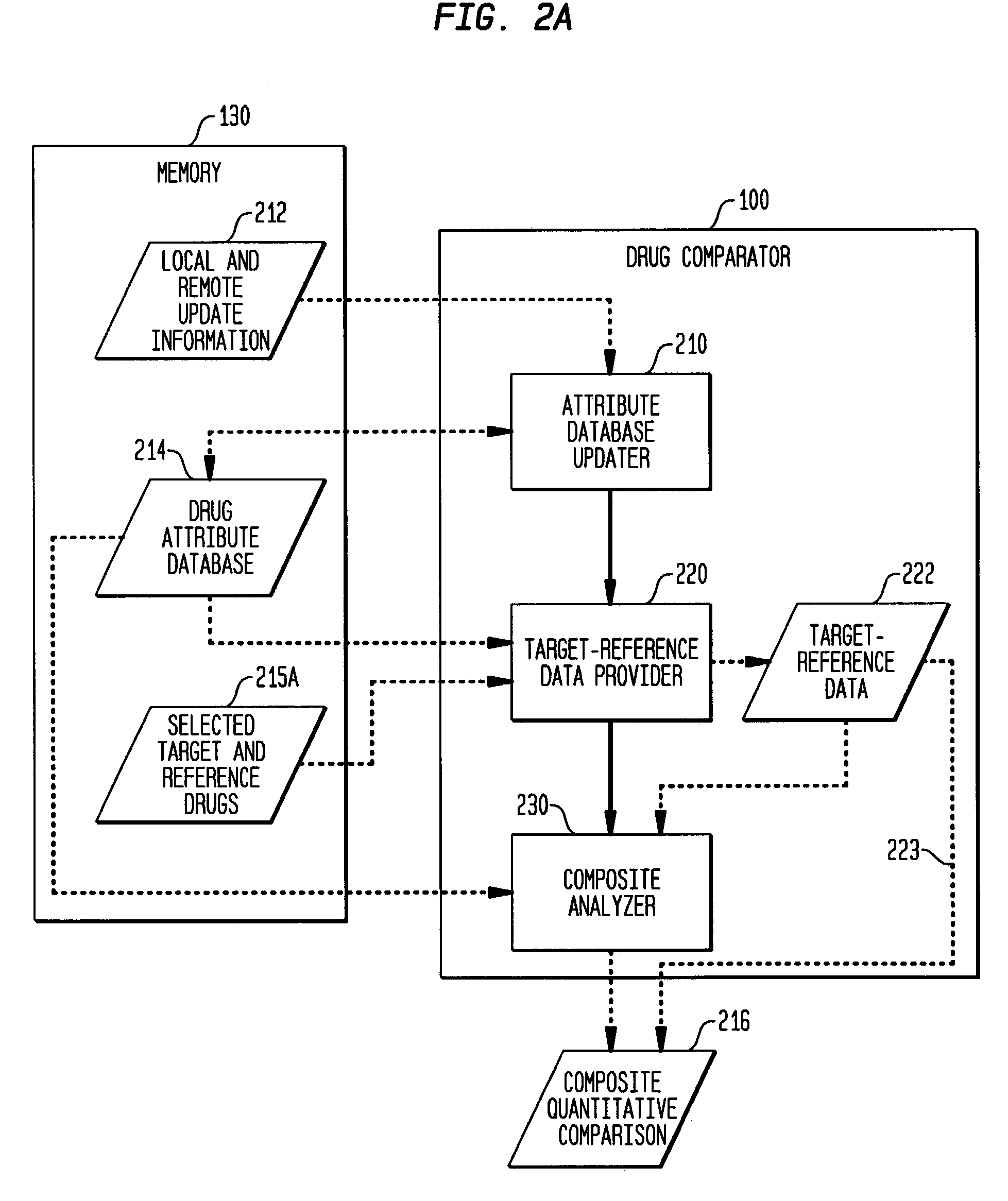[0014]In one aspect of the invention, a drug comparator for assessing the confusability of one or more target drugs and one or more reference drugs based on one or more attributes of each target drug and each reference drug is disclosed. The drug comparator comprises a name attribute comparator that performs a composite quantitative comparison of a name attribute of the one or more target drugs and the one or more reference drugs and generates one or more name-attribute similarity scores based on said comparison. Each name-attribute similarity score represents a similarity of the compared name attributes, wherein the name attribute comparator comprises two or more analyzers selected from the group consisting of an orthographic analyzer that generates one or more name-attribute similarity scores based on one or more orthographic measures of the name attributes of the one or more target and reference drugs, a phonetic analyzer that generates one or more name-attribute similarity scores based on one or more phonetic measures of the name attributes of the one or more target and reference drugs, and a phonological analyzer that generates one or more name-attribute similarity scores based on one or more phonological measures of the name attributes of the one or more target and reference drugs.
[0015]In another aspect of the invention, a drug comparator for assessing the confusability of one or more target drugs and one or more reference drugs based on one or more attributes of each target drug and each reference drug is disclosed. The drug comparator comprises a product attribute comparator that performs a composite quantitative comparison of at least one product attribute of the one or more target drugs and the one or more reference drugs and generates one or more product-attribute similarity scores based on said comparison. Each product-attribute similarity score represents a similarity of the compared product attributes, wherein the product attribute comparator comprises any one or more comparators selected from the group consisting of a strength comparator that generates at least a first product-attribute similarity score based on one or more dosage strengths of the target and reference drugs, an indication comparator that generates at least a second product-attribute similarity score based on one or more indicated uses of the target and reference drugs, a dosage form comparator that generates at least a third product-attribute similarity score based on one or more dosage forms of the target and reference drugs, an administration route comparator that generates at least a fourth product-attribute similarity score based on one or more administration routes of the target and reference drugs, a manufacturer comparator that generates at least a fifth product-attribute similarity score based on one or more manufacturers of the target and reference drugs, a pharmacological category comparator that generates at least a sixth product-attribute similarity score based on one or more pharmacological categories of the target and reference drugs, a storage requirements comparator that generates at least a seventh product-attribute similarity score based on one or more storage requirements of the target and reference drugs, a color comparator that generates at least an eighth product-attribute similarity score based on one or more colors of the target and reference drugs, a shape comparator that generates at least a ninth product-attribute similarity score based on one or more shapes of the target and reference drugs, a legal standing comparator that generates at least a tenth product-attribute similarity score based on one or more legal standings of the target and reference drugs, a trademark description comparator that generates at least an eleventh product-attribute similarity score based on one or more goods and services trademark descriptions of the target and reference drugs, and a schedule comparator that generates at least a twelfth product-attribute similarity score based on one or more dosage intervals of the target and reference drugs.
[0016]In a further aspect of the invention, a drug comparator for assessing the confusability of one or more target drugs and one or more reference drugs based on one or more attributes of each target drug and each reference drug is disclosed. The drug comparator comprises a name attribute comparator that performs a composite quantitative comparison of a name attribute of the one or more target drugs and the one or more reference drugs and generates one or more name-attribute similarity scores based on said comparison. Each name-attribute similarity score represents a similarity of the compared name attributes. A product attribute comparator performs a composite quantitative comparison of at least one product attribute of the one or more target drugs and the one or more reference drugs and generates one or more product-attribute similarity scores based on said comparison, each product-attribute similarity score representing a similarity of the compared product attributes, wherein the drug comparator automatically generates the attribute similarity scores upon receipt of an indication of the one or more target drugs.
[0017]In yet another aspect of the invention, a drug comparator for assessing the confusability of one or more target drugs and one or more reference drugs based on one or more attributes of each target drug and each reference drug is disclosed. The drug comparator comprises a name attribute comparator that performs a composite quantitative comparison of a name attribute of the one or more target drugs and the one or more reference drugs and generates one or more name-attribute similarity scores based on said comparison. Each name-attribute similarity score represents a similarity of the compared name attributes, and a neighborhood density calculator calculates a neighborhood density score for at least a first target drug of the one or more target drugs based on a number of a first set of reference drugs, wherein each of the first set of reference drugs has a determined distance from the first target drug that is not greater than a threshold distance, wherein each determined distance is a function of the one or more attribute similarity scores.
[0018]In a further aspect of the invention, a drug comparator for assessing the confusability of one or more target drugs and one or more reference drugs based on one or more attributes of each target drug and each reference drug is disclosed. The drug comparator comprises a name attribute comparator that performs a composite quantitative comparison of a name attribute of the one or more target drugs and the one or more reference drugs, and generates one or more name-attribute similarity scores based on said comparison, each name-attribute similarity score representing a similarity of the compared name attributes, and a neighborhood familiarity calculator that calculates a neighborhood familiarity score for at least a first target drug of the one or more target drugs based on a familiarity of the first target drug and the familiarity of each of a first set of reference drugs, wherein each of the first set of reference drugs has a determined distance from the first target drug that is not greater than a threshold distance, wherein each determined distance is a function of the one or more attribute similarity scores.
[0019]It should be understood that a number of embodiments and implementations of the invention are possible, along with different aspects that may be included in each of the summarized embodiments. It should also be understood that the embodiments, implementations, and / or aspects are not necessarily inclusive or exclusive of each other and may be combined in any manner that is non-conflicting and otherwise possible. It should also be understood that these embodiments, implementations, and / or aspects of the invention are exemplary only and are considered to be non-limiting. Further, various embodiments, implementations, and / or aspects of the present invention provide certain advantages and overcome certain drawbacks of conventional techniques while other embodiments, implementations, and / or aspects provide the same or different advantages and overcome the same or other drawbacks in the same or different manner. Thus, not all embodiments, implementations, and / or aspects of the invention share the same advantages, and those that do may not share them under all circumstances.
 Login to View More
Login to View More  Login to View More
Login to View More 


